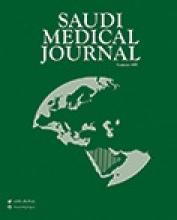Abstract
OBJECTIVE: Juvenile megaloblastic anemia is a rare and often hereditary disorder of cobalamin absorption, transport or intracellular metabolism. Several syndromes present with megaloblastic anemia such as congenital megaloblastic anemia due to intrinsic factor defect and juvenile megaloblastic anemia with proteinuria due to defects in the cubilin or the amnionless protein.
METHODS: We identified a large kindred with juvenile megaloblastic anemia. Four genes, GIF, CUBN, TCN1, and TCN2, was previously excluded from being responsible for the syndrome of this family who was discovered in Irbid, Jordan, during the year 1999. At that time, the amnionless (AMN) gene was not yet known to implicate in megaloblastic anemia. In this study, we screened the AMN for mutations in the Ohio State University, Iowa, United States of America. In addition, follow-up testing was carried out in the University of Iowa in 2004.
RESULTS: We identified a homozygous splice site mutation in the patients. This mutation was previously detected in families from Turkey and Tunisia. It is suspected to be a founder mutation of Middle Eastern origin.
CONCLUSION: Molecular testing for this specific mutation in cases of Middle Eastern origin is a valuable tool for presymptomatic diagnosis, carrier identification and perhaps prenatal diagnosis.
- Copyright: © Saudi Medical Journal
This is an open-access article distributed under the terms of the Creative Commons Attribution-Noncommercial License (CC BY-NC), which permits unrestricted use, distribution, and reproduction in any medium, provided the original work is properly cited.






